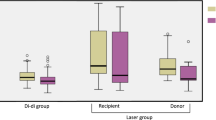Abstract
OBJECTIVE:
The purpose of this study was to evaluate the prognostic value of sonographic and clinical parameters to develop a staging classification of twin-twin transfusion syndrome (TTTS).
STUDY DESIGN:
Severe TTTS was defined as the presence of polyhydramnios (maximum vertical pocket of ≥8 cm) and oligohydramnios (maximum vertical pocket of ≤2 cm). Nonvisualization of the bladder in the donor twin (−BDT) and absence of presence of hydrops was also noted. The middle cerebral artery, umbilical artery, ductus venosus, and umbilical vein in both fetuses were assessed with pulsed Doppler. Critically abnormal Doppler studies (CADs) were defined as absent/reverse end-diastolic velocity in the umbilical artery, reverse flow in the ductus venosus, or pulsatile flow in the umbilical vein. TTTS was staged as follows: stage I, BDT still visible; stage II, BDT no longer visible, no CADs; stage III, CADs; stage IV, hydrops; stage V, demise of one or both twins. Laser photocoagulation of communicating vessels (LPCV) or umbilical cord ligation was performed depending on the severity of the condition. The study was approved by the Institutional Review Board of St. Joseph’s Hospital in Tampa and by the Fetal Therapy Board at Hutzel Hospital, Detroit, and all patients gave informed consent.
RESULTS:
A total of 80 of 108 referred patients met criteria for surgery, but only 65 were treated surgically: 48 with LPCV and 17 with umbilical cord ligation. Complete Doppler data were obtainable in 41 of 48 LPCV patients. Survival rates by stage for one or two fetuses were statistically different (χ-squared analysis = 12.9, df = 6, p = 0.044). Neither percent size discordance nor gestational age at diagnosis were predictive of outcome.
CONCLUSION: Staging of TTTS using the proposed criteria has prognostic significance. This staging system may allow comparison of outcome data of TTTS with different treatment modalities.
This is a preview of subscription content, access via your institution
Access options
Subscribe to this journal
Receive 12 print issues and online access
$259.00 per year
only $21.58 per issue
Buy this article
- Purchase on Springer Link
- Instant access to full article PDF
Prices may be subject to local taxes which are calculated during checkout
Similar content being viewed by others
Author information
Authors and Affiliations
Rights and permissions
About this article
Cite this article
Quintero, R., Morales, W., Allen, M. et al. Staging of Twin-Twin Transfusion Syndrome. J Perinatol 19, 550–555 (1999). https://doi.org/10.1038/sj.jp.7200292
Published:
Issue Date:
DOI: https://doi.org/10.1038/sj.jp.7200292
This article is cited by
-
Neonatal hemodynamics of recipient twins after fetoscopic selective laser coagulation for twin-to-twin transfusion syndrome: An unicist classification
European Journal of Pediatrics (2024)
-
Developmental outcomes for survivors of placental laser photocoagulation for the management of twin-to-twin transfusion syndrome
BMC Pregnancy and Childbirth (2023)
-
Association between fetal growth-restriction and retinopathy of prematurity using a unique identical twin model
Pediatric Research (2023)
-
Neonatal and developmental outcomes of very preterm twins according to the chorionicity and weight discordance
Scientific Reports (2023)
-
Intra-abdominal umbilical venous diameter and abdominal circumference discordance at 15–20 weeks’ gestation: simple markers in transverse abdominal plane to predict adverse pregnancy outcomes in monochorionic diamniotic twins
Archives of Gynecology and Obstetrics (2023)



